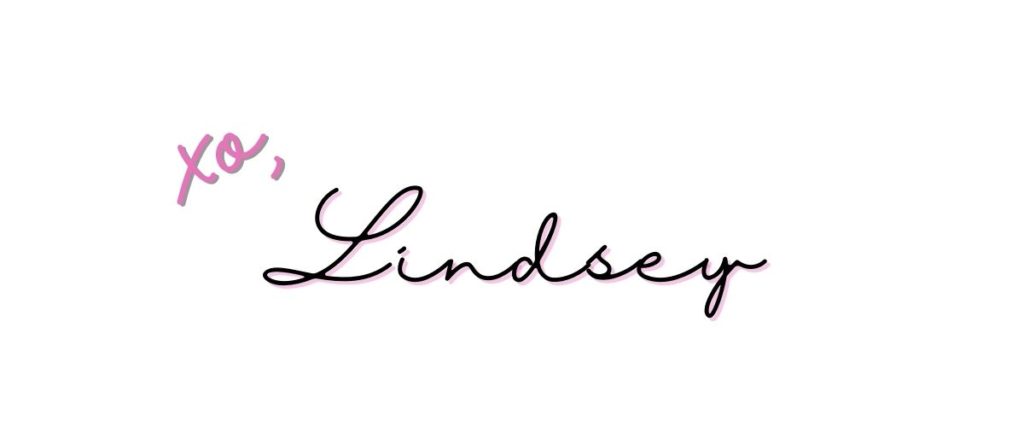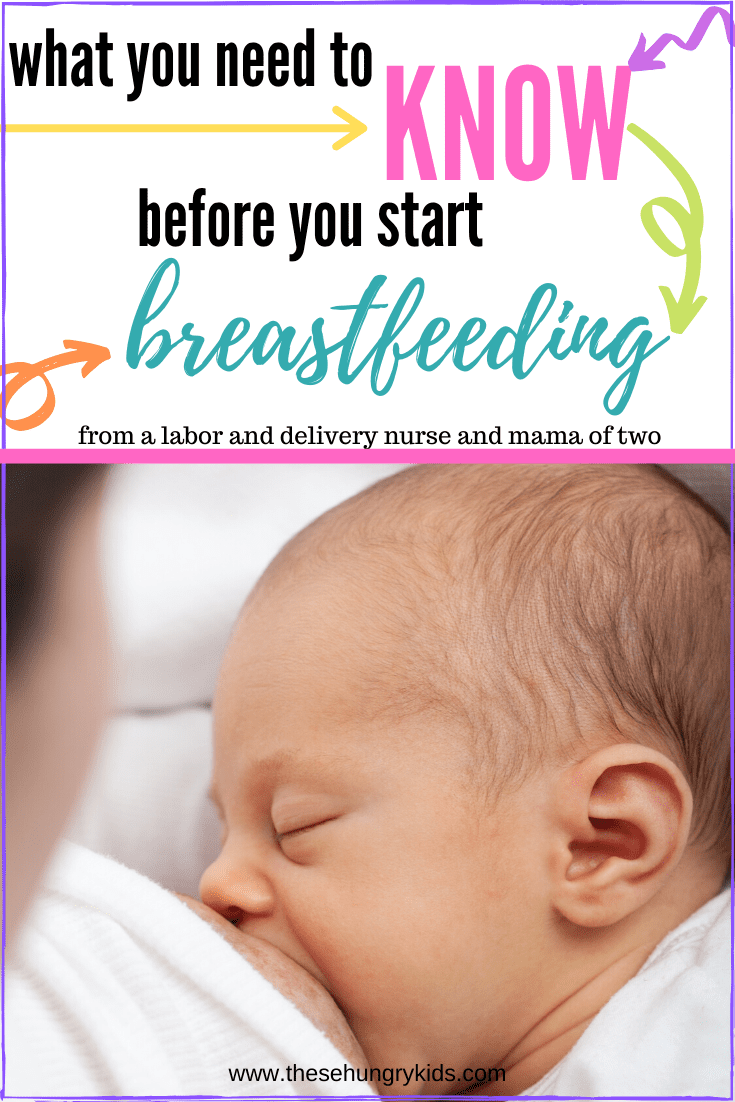Sharing is caring!
I’m still breastfeeding my youngest baby, and she will be 9 months old next week. Our journey has been much easier this time around. I think a big part of that has to do with how much more relaxed I am.
Immediately after she was born, I got her right to breast and nursed for almost 45 minutes! I did have a problem with oversupply and mastitis, but that was largely due to over pumping. We had to supplement with bottled breastmilk in her first few days because she had hyperbilirubinemia and needed to poop more.
I pumped a little after every feed, and eventually my body started making 40+ ounces extra every day. I have an amazing freezer stash, but it was more of a nuisance than anything.
I’ve written the basics of breastfeeding down below. It’s a combination of what I’ve learned as a breastfeeding mom and also as a labor and delivery nurse.
If you have any concerns about feeding or breastfeeding, please consult with your healthcare provided. This article is intended only to share my experiencesand does not replace the need for medical attention.
You can do this, mama! It’s a new experience for both you and your baby, and it will take some time to learn. Everyone feels overwhelmed and exhausted by breastfeeding at first, but eventually it just becomes part of your routine. Do not fear – within a few weeks you will both have this nursing thing mastered
Please note: The views on this website are personal opinions only and do not represent the opinions or policies of any provider or institution that I am affiliated with. This information is not medical advice. Information on this website is not intended to diagnose, or treat any form of any disease. This article is for informational and entertainment purposes only. You should always refer to your own medical provider when making medical decisions for yourself and/or your baby. Please refer to my Terms and Conditions for more information
This post may contain affiliate links. I may earn a small commission at no cost to you if a purchase is made using the links on this page.
Getting Started with Breastfeeding
The first few feedings may feel intimidating. Ask if your hospital has a lactation consultant that can work with you to find the right position for a good latch.
You may wish to use a Boppy or other nursing pillow.
I personally liked the My Brest Friend. It offers more support than the Boppy, which we mostly used for tummy time or back support when learning to sit. The My Brest Friend pillow straps around your back and is adjustable. It also has more support and is a little firmer than other nursing pillows.
I am a very average sized person…but for whatever reason I could NOT position myself properly with the Boppy! I always felt like the baby wasn’t supported and not close enough to me.
Take Care of Your Nipples!
You are going to want to take care of your nipples BEFORE they start hurting. You may not feel any nipple discomfort at first, but most moms experience it eventually.
The best thing you can do is go topless (or at least braless) and let a few drops of milk dry onto your nipples after every feed.
Additionally, you may wish to use a nipple cream. I liked the Lansioh brand and the Motherlove Nipple Cream. Do not buy a ton of this. You will probably only need to use this the first week or two of breastfeeding. Use this BEFORE you’re feeling sore!
A good latch is the best way to protect your nipples. If your baby consistently has a bad latch, your nipples will pay for it! A Certified Lactation Consultant (CLC) can watch you latch your baby to make sure they are deep enough onto your nipples.
There may come a time when you want to go topless, and mama let. them. hang. Your visitors can wait until you’re more comfortable!
Latching
Latching is the way your infant attaches to your breast. In the beginning, both you and baby are learning what a good latch is, and it can take several tries to get a good latch during a feeding. Within a few days to weeks, you’ll both have the hang of it.
I had a very difficult time getting my oldest to latch. We ended up using a nipple shield, and that was the only way she could feed the first 4-5 months of her life. We ended up finding that she had an upper lip tie, which was the reason for her difficulty latching. The nipple shield was great for helping her latch, but it was very annoying to carry around and clean after each feeding.
The latch should be deep, with your entire nipple inside the baby’s mouth. The baby’s lips should look like fish lips, with both lips on the outside of their mouth touching the breast. You should feel a tugging and pulling sensation, not a pinching/burning sensation.
An exception to this is if you have sore nipples from the first few days/week of breastfeeding.If your nipples are reddened and raw from breastfeeding, you may have that burning sensation after the initial latch that goes away when the baby continues feeding.
If the latch is shallow or uncomfortable, break the latch with your finger and try again. It will not only continue hurting you and your nipples, it will cause the baby to take in extra air and become gassy and uncomfortable. A poor latch can also decrease your milk supply.

The Importance of Skin to Skin
It was always hard for me to do a ton of skin to skin after birth because I always had a lot of visitors, but do not feel bad asking people to leave when you nurse or go skin to skin if it makes you uncomfortable.
Being skin to skin is not only great for bonding, it helps the baby learn your smells and the smell of your milk and releases hormones in your body to help your milk supply and let down.
Colostrum vs. Breastmilk: What's the Difference?
When you first start your breastfeeding journey, you will not have that “full” and “empty” feeling you may have expected. That’s because in the first few days you make colostrum. You may feel like your baby is not getting enough to eat, but that’s because they only need a few drops to feel full.
Colostrum
Colostrum is a very calorie dense, sticky, sweet milk that provides a lot of nourishment and antibodies for your baby. It is the BEST thing for your baby to eat. Even though formula may provide a higher volume of milk, it cannot compare to the nutrition of colostrum.
A few days after birth, your milk should come in. You may experience feeling engorged, or very swollen with milk. The best way to relieve this is feeding your baby or using the breast pump.
Be careful with pumping, you don’t want to over pump and cause an oversupply. You might also start to experience a let-down sensation. Not every feels their let-down, so don’t be alarmed if you don’t notice one.
This is a really great article about what a let-down is if you’re looking for more information.
How Do I Know If My Baby is Eating Enough?
Your pediatrician should be assessing the baby’s growth and weight to help you determine if your baby is growing appropriately and eating enough. If you are concerned about your baby’s eating, consult your pediatrician.
Additionally, you can look at the baby’s cues. After a feed, your baby should look relaxed, calm, and sometimes sleepy. If they seem tense and restless, they may not be eating enough.

When should I feed my baby?
The first few weeks, your baby should be eating every 2-4 hours. The best way to know when your baby is ready to eat is by watching for hunger cues. If you wait until your baby is screaming in hunger, it will be harder to latch. Cues to look for include:
- Baby is alert and active
- Opening mouth and turning head (rooting reflex)
- Sucking on hands
- Smacking lips
- Baby is becoming fidgety and squirmy
Boosting Milk Supply
If you aren’t making enough milk, there may be a reason why. Certain medications, foods and medical conditions can cause this. Check with your doctor to see if any of that applies to you.
If that doesn’t apply to you, there are a few things you can do to increase milk supply.
- Power pumping: breastfeeding is supply and demand, so power pumping is the best way to increase milk supply in my opinion. There are lots of different ways to power pump, but the idea is that after you breastfeed, you pump for 20 minutes on, 10 minutes off and then more 10 minutes on. This tells your body that you need to make more milk than what’s already being produced by emptying your breasts completely
- Foods: there is little research to support this, but many moms report that certain foods and drinks have increased milk supply. Drinks like mother’s milk tea, Gatorade, Powerade and Body Armor have been reported to temporarily boost supply. Oatmeal, brewer’s yeast and honey have also been reported to increase supply. You may have to try a few out to see if any work for you.
- Supplements: as with anything, ask your healthcare provider before trying supplements, but there are many different supplements found in pharmacies that claim to increase supply.
Leaking
Baby cries…books leak.
Baby looks cute….boobs leak.
You’re thinking about how cute your baby is….boobs leak.
Your baby is taking an extra long nap (YAY!) but now you’re 30 mins past your normal feeding time…boobs leak…everywhere!
Nipple pads are a must! There are many kinds to choose from, but I personally prefer the disposable ones. I don’t know how true it is, but I read about someone’s reusable nipple pads growing mold and I was so grossed out.
My favorite are the Lansinoh brand of disposable pads. They have adhesive that sticks to the inside of your bra and they’re the softest kind I’ve used. They’re inexpensive and a lot come in a pack, which is great because there are days when I used a LOT of them.
I personally only needed these for the first few weeks, but I know some women need them the whole time they breastfeed.
Take Care of You, Too
Having a new baby and breastfeeding is a lot. No matter how your baby got here, giving birth is a major strain on your body.
Every time you sit down to nurse, grab a snack and a glass of water. You can turn on some music, sing your baby a song, and make your time nursing your little one a relaxing and enjoyable experience.
If you’re just getting started on your breastfeeding journey, I wish you the best of luck! It’s a wonderful way to nourish your little one and provides a great opportunity to bond. There’s nothing better than the warmth and weight of your little one against your chest. It’s something I will really miss when my babies are older!




Very informative! Thank you for sharing this.
I’m glad you think so! <3
Pingback: How to Get the Perfect First Latch Breastfeeding - Love Our Littles®